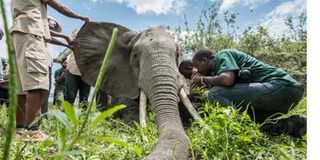Tanzania collaring 13 elephants in 10 days as part of anti-poaching drive

What you need to know:
The anti-poaching drive is being implemented by the Tanzania Wildlife Research Institute (Tawiri) in Mikumi National Park and Selous Game Reserve, according to a statement issued by WWF late Wednesday.
Dar es Salaam. Tanzania government in partnership with WWF expects to fit 13 adult elephants with satellite collars in the next 10 days as part of efforts to protect the dwindling elephant population.
The anti-poaching drive is being implemented by the Tanzania Wildlife Research Institute (Tawiri) in Mikumi National Park and Selous Game Reserve, according to a statement issued by WWF late Wednesday.
The completion of the exercise will have a total of 20 GPS satellite collars fitted on adult elephants in core areas and outside the core areas of Selous Ecosystem.
The fitting of satellite collars with improved technology will facilitate the collection of data for effective monitoring and security provision to large mammal movements, especially the elephants that have in recent years been decimated by poaching.
The fitting of GPS collars will also strengthen elephant conservation efforts in Selous Game Reserve by alerting field teams where each elephant’s family is heading to and help move them away from croplands and reduce the risk of human-wildlife conflicts.
It will also identify critical habitats, seasonal dispersal areas and corridors for elephants that may require enhanced protection.
WWF Tanzania country director, Dr Amani Ngusaru, says his organization is excited to be part of efforts to attain zero poaching in the Selous Game Reserve.
“The use of satellite collars is a proven technology as an effective measure to monitor wildlife movements and at providing a security function. WWF hopes that this exercise will enhance the security that is needed to protect elephants especially from poaching. The Greater Selous ecosystem requires special attention of all concerned conservation partners because it is the only area that can guarantee a sufficient space for elephants and other wildlife but it is also of ecological importance because it is home to huge, diverse and exceptional Miombo and Savanna ecosystem as well as a designated World Heritage Site by UNESCO,” he says.
The collaring exercise which began in December 2017, targeting 60 elephants, is being done in phases depending on prevailing weather conditions. Only one elephant will be collared in a herd; elephants found in Wildlife Management Areas or outside core protected areas will be preferred to be fitted a unit than those in a core area.
“Some results that have been received from the previously collared elephants are interesting. There are two very active elephants: one in the Selous and one that moves in and out of the Selous visiting village lands in the east. This elephant and her herd are causing villagers problems so resources are being put in place to stop the elephants entering village lands,” he added.
During this phase the collaring will be supported by a helicopter and with an estimated planned total of 34 hours flying time in Mikumi and Selous’ Miguruwe, Liwale, Kalulu, Likuyu-Seka and Liwale sectors.
WWF has supported Tanzania Wildlife Management Authority (TAWA) through Tanzania Wildlife Research Institute (TAWIRI) to fit GPS satellite collars in Selous Game Reserve because through its expansive nature of the wilderness it has immense potential for harbouring huge numbers of elephants as a springboard for increased tourism growth to support an expanded sustainable socio-economic development in the country.
In the last two collaring exercises the GPS satellite collars were fitted to elephants in Matambwe sector in Selous Game Reserve and Mikumi National Park only.




